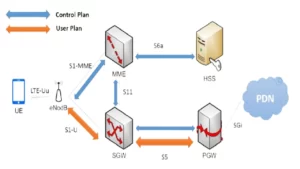In the last post, we covered everything about the 3G network: the network generation that massively increased the speed of transmission of signals in wireless telecommunications technology, enabling video calls, video conferences, and other high-data services.
Though 3G satisfied the goal of enjoying high-speed data services to a great extent, it still had some limitations. For instance, 3G had limited applications for high-bandwidth services like video streaming. It was also inefficient in terms of network coverage over long distances.
Fortunately, the development of 4G addressed most of these limitations. Beyond enhancing high-bandwidth applications, the 4G network brought many other improvements to wireless telecommunication technology by increasing network coverage, lowering latency in transmission, and enhancing multimedia services.
In this article, we will cover everything you need to know about the 4G network, beginning with how it evolved and then extending it to some of the mobile phones (4G phones) that utilize this technology.
What is a 4G network?
The 4G network is the fourth generation of broadband cellular network technology that uses the IMT Advanced standard to provide faster internet speed, better call quality, and improved data transfer rates compared to its predecessor, 3G.
4G allows mobile devices to access the internet at speeds up to 100 Mbps, with the potential to reach 1 Gbps in some cases.
Evolution of the 4G Network
The evolution of 4G networks began with two major competing technologies: mobile WiMAX (Worldwide Interoperability for Microwave Access) and LTE (Long-Term Evolution). Both technologies were developed in the mid-2000s and were designed to provide faster data rates and better network efficiency compared to 3G networks.
Mobile WiMAX was based on the IEEE 802.16 standard and was developed by the WiMAX Forum, a consortium of telecommunications companies.
Because WiMAX promised to deliver high-speed wireless broadband access to fixed, portable, and mobile devices, it was initially seen as a strong contender for the next-generation network (4G). However, the technology faced a number of challenges, including limited device support, high deployment costs, and network interference issues.
LTE, on the other hand, was developed by the 3rd Generation Partnership Project (3GPP), a collaboration between telecommunications standards organizations. LTE was designed to be a more efficient and flexible alternative to the existing 3G networks, with the aim of supporting a wide range of data-intensive services such as video streaming, online gaming, and cloud computing.
In 2008, the International Telecommunication Union-Radio (ITU-R) set the criteria for 4G networks, which required peak data rates of at least 100 Mbps for high-mobility communication (such as in a car) and 1 Gbps for low-mobility communication (such as pedestrians).
According ITU, any network technology must meet the following requirement before it be called 4G;
- Be based on an all-IP packet-switched network.
- Have transfer speed of 100 Mbit/s for high mobility, and 1 Gbit/s for low mobility.
- Be able to dynamically share and use the network resources to support more simultaneous users per cell.
- Have bandwidths within 5–20 MHz, or even up to 40 MHz
- Have Smooth handovers across networks
- Have a maximum data transfer rate of 15 bits per second per hertz of available bandwidth in downlink and 6.75 bits per second per hertz in uplink
Both mobile WiMAX and early versions of LTE failed to meet these requirements so they were not fully accepted as 4G network.
Later in 2009, LTE Release 8, was launched and it offered peak download speeds of up to 100 Mbps, which fell short of the ITU-R’s 4G requirements. Subsequent releases of LTE, including Release 10 and Release 11, introduced advanced features such as carrier aggregation, enhanced multimedia broadcast multicast services, and support for voice over LTE (VoLTE), which significantly improved network performance and efficiency.
In 2011, the ITU-R revised its definition of 4G to include any network technology that provided a “substantial level of improvement” over 3G networks, even if it did not meet the original peak data rate requirements. This allowed LTE and other technologies to be classified as 4G even though they did not meet the original criteria.
Also in 2011, IEEE approved the 802.16m standard, also known as WiMAX 2, which was designed to offer even higher data rates and improved network efficiency compared to the original Mobile WiMAX standard. However, at this point, LTE had gained widespread industry support and had become the dominant 4G technology.
Today, LTE is the most widely deployed 4G technology, with over 4 billion LTE connections worldwide. The latest version of LTE, known as LTE Advanced Pro, offers peak data rates of up to 3 Gbps and supports a wide range of advanced features, such as carrier aggregation, 256 QAM modulation, and massive MIMO.
4G network architecture
A network architecture is an infrastructure that helps deliver messages from sender to receiver.
The 4G network architecture consists of several key components, which include User Equipment (UE), Evolved Node B (eNodeB), Serving Gateway (SGW), Packet Data Network Gateway (PGW), Packet Data Network (PDN), Mobility Management Entity (MME), and Home Subscriber Server (HSS).

Let’s take explain each of these components one by one.
User Equipment (UE): UE is the device used by the end-user to connect to a network( 4G in this case). It consists of a smartphone, a tablet, or any other device that can accept a SIM card and transmit a radio wave.
The device (a cell phone) is used to transmit the radio wave from sender to receiver, while the SIM card registers the user in a network. The UE communicates with the eNodeB via the air interface using radio waves.
Evolved Node B (eNodeB): The eNodeB is the base station of the 4G network. It communicates with the UE via the air interface and connects to the core network via the S1 interface. The eNodeB is responsible for handling radio resource management, scheduling, and handovers.
Serving Gateway (SGW): The SGW is the central node in the data path between the UE and the PDN. It is responsible for routing user data packets to and from the eNodeB and the PDN.
Packet Data Network Gateway (PGW): The PGW is the gateway between the 4G network and external networks, such as the internet or private networks. It is responsible for performing IP address allocation for the UE and acts as the point of interconnection between the 4G network and external networks.
Packet Data Network (PDN): The PDN is the network that the UE is accessing via the 4G network. It could be the internet or a private network.
Mobility Management Entity (MME): The MME is responsible for controlling the signaling between the UE and the core network. It is responsible for managing UE authentication, mobility management, and session management.
Home Subscriber Server (HSS): The HSS is the database that stores user profile information, including authentication and authorization information. It is responsible for authenticating and authorizing the UE to access the 4G network.
Here is the working principle of the 4G network architecture;
When a UE wants to access the 4G network, it initiates a connection with the eNodeB. The eNodeB then sends a request to the MME to authenticate the UE. If the UE is authenticated, the MME assigns it a temporary identifier and establishes a session with the SGW. The SGW then assigns an IP address to the UE and sets up a connection with the PGW to access the PDN. The PGW then routes the user data packets to and from the PDN.
Features of the 4G network
Features introduced to wireless telecommunication by the 4G network include the following:
- Amended mobile web access,
- IP telephony,
- Gaming services,
- High-definition mobile TV,
- Video conferencing,
- 3D television.
Fourth-generation mobile phones (4G phones)
Fourth-generation mobile phones are cell phones that use 4G technology to provide faster data transfer rates, wider coverage, and more advanced features than 3G phones simply could not provide.
Fourth-generation (4G) phones offer a range of advanced features that enhance mobile web access, communication, and multimedia experiences. Some of these features include improved IP telephony, gaming services, high-definition mobile TV, video conferencing, and even 3D television.

Examples of 4G phones are the Apple iPhone 12, Samsung Galaxy S21, OnePlus 9, and Xiaomi Mi 11. These phones are available at different phone stores worldwide.
Limitations of the 4G network
4G network has the following limitations;
- It had limited coverage in rural areas with limited infrastructure.
- Capacity: 4G has limited capacity, which will lead to slower speeds and degraded network performance when people connect to it.
- Low battery life due to high-speed data transfer
- The cost of building and maintaining a 4G network is expensive.
- Interference
- Insecure
- Need complete hardware
- Network protocol and standardization have not been defined.
- Roaming and data or voice work together but have not yet been implemented.
- require a closer base station and are expensive.
Conclusion
With what we have covered in this post, you have seen the improvements that 4G networks have brought to wireless communication technology. It introduced IP telephony, gaming services, high-definition mobile TV, and video conferencing, which the earlier generation networks simply could not provide.
In the next article, we will be exploring the 5G network. Consider checking it out.

I am a passionate Networking Associate specializing in Telecommunications.
With a degree in Electronic engineering, I possess a strong understanding of electronic systems and the intricacies of telecommunications networks. I gained practical experience and valuable insights working for a prominent telecommunications company.
Additionally, I hold certifications in networking, which have solidified my expertise in network architecture, protocols, and optimization.
Through my writing skills, I aim to provide accurate and valuable knowledge in the networking field.
Connect with me on social media using the links below for more insights.
You can contact me using [email protected] or connect with me using any of the social media account linked below


